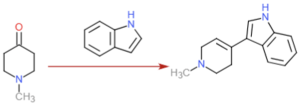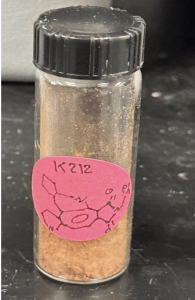RESEARCH IN CHEMISTRY AND BIOCHEMISTRY
Synthesis of Isatisindigoticanine G and its Analogues for Candida auris inhibition
By Kerolos Markos
OBJECTIVE:
The objective of this research is to develop novel inhibitors for Candida auris based on quinazolinone natural product. This would require developing a novel and efficient synthetic method for the synthesis of pyrido quinazoline natural product and its analogues for screening. We propose to develop a modular approach for the same from piperidones.
LAB WORK:
1. Working with Methyl piperidone
 |
Fig. 1.1 — Methyl piperidone with indole.
In this experiment I set up a table as follows:
| Vol. (ml) | Mass (g) | Molar Mass (g/mol) | Density
(g/ml) |
Moles | Eq. Moles | |
| Indole | – | 3 g | 117.15 | – | 0.0256 | 1 |
| Methyl piperidone | 2.96 ml | 2.898 g | 113.16 | 0.98 | 0.0256 | 1 |
| Reagent | 2.1 ml | 1.82 g | 71.11 | 0.866 | 0.0256 | 1 |
Table 1.2 shows the reactant used in the experiments.
Synthesis of 3-(1-methyl-1,2,3,6-tetrahydropyridin-4-yl)-1H-indole: A solution of 1H-indole, 1-methylpiperidone, pyrrolidine in ethanol (30 mL) was refluxed for an additional 24 hours. The reaction was brought to room temperature, then cooled to 0C, stirred for 30 minutes. The solid was filtered, washed with cold ethanol (2×15 mL), and dried under high vacuum to obtain the title compound as a white solid t as shown in figure 1.3. Total mass is 1.3607 g.

Fig. 1.3 — White Solid Obtained.
H-NMR was conducted to the white solid using DMSO as a solvent (figure 1.4).

Fig. 1.4 — H-NMR for 1-methyl-1,2,3,6-tetrahydropyridin-4-yl
2. Adding N-Phenylmaleimide
| Mass | Molar Mass | Moles | |
| 3-(1-methyl-1,2,3,6-tetrahydropyridin-4-yl)-1H-indole | 1 g | 212.29 g/mol | 0.0047 |
| N- phenylmaleimide | 0.8157 g | 0.8157 g | 0.0047 |
Table 2.1 — Reactant for the Experiment.
 |
Fig. 2.2 — Reaction Scheme.
Synthesis of 5-methyl-2-phenyl-5,6,7, 12-tetrahydropyrido[3,4-c]pyrrolo[3,4-a]carbazole-1,3(2H,4H)-dione: A solution of 3-(1 -methyl-1,2,3,6-tetrahydropyridin-4-yl)-1H-indole, N- phenylmaleimide in toluene (10 mL) was refluxed for additional 16 hours. The reaction was brought to room temperature, then the solid was filtered, washed with cold methanol (15 mL) and dried under high vacuum to obtain the title compound as a red solid t as shown in figure 2.3. Total mass is 1.745 g.
The product got purified again by using 50%/50% hexane and ethyl acetate as a solution and added the red solid to the solution. We started boiling the solution and then let it cool on room temperature for 5 days. Then obtained the crystals again.

Fig. 2.3 — Red Solid Obtained.
H-NMR was conducted to the red solid using CDCl4 as a solvent (figure 2.4).

Figure 2.4 HNMR for the 5-methyl-2-phenyl-5,6,7, 12-tetrahydropyrido[3,4-c]pyrrolo[3,4-a]carbazole-1,3(2H,4H)-dione
3. Using 2,4-Piperidinedione
We started doing the same experiments as in 1 and 2 using 2,4-piperidinedione instead of methyl piperidone.
| Mass | Molecular Weight | Moles | |
| 2,4-piperidinedione | 1 g | 113.11 g/mol | 0.00884 |
| Indole | 1.0356 g | 117.15 g/mol | 0.00884 |
Table 3.1 — Reactant for the Experiment.
A solution of 2,4-piperidinedione in methanol (20 mL) was refluxed for an additional 24 hours. The reaction was brought to room temperature.
 |
Fig. 3.2 — Reaction Scheme.
Doing TLC for the product by adding the product liquid into air vacuum, after 15 minutes it turned into solid. Then add Na2CO3, H2O then ethyl acetate in test tube; the top layer (the organic layer) was isolated and added to the TLC plate. The TLC plate was put in a solution of 100% ethyl acetate for 1 minute and then observed under UV light.

Fig. 3.3 — TLC Plate.
Unfortunately, the 2,4 piperidinedione as a reactant didn’t get involved in the reaction because the initial spot didn’t move.
Another experiment was conducted using 2,4 piperidinedione and isatoic acid but unfortunately we didn’t have enough time because of the finals.

